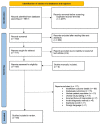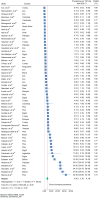The global prevalence of human fascioliasis: a systematic review and meta-analysis
- PMID: 37434654
- PMCID: PMC10331341
- DOI: 10.1177/20499361231185413
The global prevalence of human fascioliasis: a systematic review and meta-analysis
Abstract
Background: Fascioliasis is a parasitic zoonosis that can infect humans and be a source of significant morbidity. The World Health Organization lists human fascioliasis as a neglected tropical disease, but the worldwide prevalence of fascioliasis data is unknown.
Objective: We aimed to estimate the global prevalence of human fascioliasis.
Data sources and methods: We performed a systematic review and prevalence meta-analysis. We used the following inclusion criteria: articles published in the English, Portuguese, or Spanish languages from December 1985 to October 2022 and studies assessing the prevalence of Fasciola in the general population with an appropriate diagnostic methodology, including longitudinal studies, prospective and retrospective cohorts, case series, and randomized clinical trials (RCTs). We excluded animal studies. Two reviewers independently reviewed the selected studies for methodological quality, performing critical standard measures from JBI SUMARI. A random-effects model was conducted of the summary extracted data on the prevalence proportions. We reported the estimates according to the GATHER statement.
Results: In all, 5617 studies were screened for eligibility. Fifty-five studies from 15 countries were selected, including 154,697 patients and 3987 cases. The meta-analysis revealed a pooled prevalence of 4.5% [95% confidence interval (CI): 3.1-6.1; I2 = 99.4%; T2 = 0.07]. The prevalence in South America, Africa, and Asia was 9.0%, 4.8%, and 2.0%, respectively. The highest prevalence was found in Bolivia (21%), Peru (11%), and Egypt (6%). Subgroup analysis showed higher prevalence estimates in children, in studies from South America, and when Fas2-enzyme-linked immunosorbent assay (ELISA) was used as a diagnostic method. A larger study sample size (p = 0.027) and an increase in female percentage (p = 0.043) correlated with a decrease in prevalence. Multiple meta-regression showed a higher prevalence for hyperendemic than hypoendemic (p = 0.002) or mesoendemic (p = 0.013) regions.
Conclusion: The estimated prevalence and projected disease burden of human fascioliasis are high. Study findings support that fascioliasis continues to be a globally neglected tropical disease. Strengthening epidemiological surveillance and implementing measures to control and treat fascioliasis is imperative in the most affected areas.
Keywords: F. gigantica; F. hepatica; epidemiology; human fascioliasis; meta-analysis; neglected tropical disease; prevalence; systematic review.
© The Author(s), 2023.
Conflict of interest statement
The authors declared the following potential conflicts of interest with respect to the research, authorship, and/or publication of this article: We declare no competing interests related to this work. Dr. Sillau reported receiving grants from the Alzheimer’s Association, the Benign Essential Blepharospasm Research Foundation, the Colorado Department of Public Health, the Davis Phinney Foundation, the Hewitt Family Foundation, the Michael J. Fox Foundation, the National Institutes of Health, the National Institute of Nursing Research, the Patient-Centered Outcomes Research Institute, and the Rocky Mountain Alzheimer’s Disease Center outside the submitted work. Dr. Henao-Martínez reported being the recipient of a K12-clinical trial award as a co-principal investigator for the Expanded Access IND Program (EAP) to provide the Yellow Fever vaccine (Stamaril) to Persons in the United States outside the submitted work. The Editor in Chief and Associate Editor of Therapeutic Advances in Infectious Disease are authors of this paper. Therefore, the peer review process was managed by alternative members of the Editorial Board and the submitting Editors had no involvement in the decision-making process. No other disclosures were reported.
Figures
Similar articles
-
Human fascioliasis in Africa: A systematic review.PLoS One. 2021 Dec 9;16(12):e0261166. doi: 10.1371/journal.pone.0261166. eCollection 2021. PLoS One. 2021. PMID: 34882738 Free PMC article.
-
Hyperendemic fascioliasis associated with schistosomiasis in villages in the Nile Delta of Egypt.Am J Trop Med Hyg. 2003 Oct;69(4):429-37. Am J Trop Med Hyg. 2003. PMID: 14640504
-
Chapter 2. Fasciola, lymnaeids and human fascioliasis, with a global overview on disease transmission, epidemiology, evolutionary genetics, molecular epidemiology and control.Adv Parasitol. 2009;69:41-146. doi: 10.1016/S0065-308X(09)69002-3. Adv Parasitol. 2009. PMID: 19622408 Review.
-
Fluke egg characteristics for the diagnosis of human and animal fascioliasis by Fasciola hepatica and F. gigantica.Acta Trop. 2009 Aug;111(2):150-9. doi: 10.1016/j.actatropica.2009.04.005. Epub 2009 Apr 16. Acta Trop. 2009. PMID: 19375410
-
Distribution of Fasciola hepatica and F. gigantica in the endemic area of Guilan, Iran: Relationships between zonal overlap and phenotypic traits.Infect Genet Evol. 2015 Apr;31:95-109. doi: 10.1016/j.meegid.2015.01.009. Epub 2015 Jan 17. Infect Genet Evol. 2015. PMID: 25602718
Cited by
-
Neglected Tropical Diseases and Female Infertility: Possible Pathophysiological Mechanisms.J Trop Med. 2025 Apr 30;2025:2126664. doi: 10.1155/jotm/2126664. eCollection 2025. J Trop Med. 2025. PMID: 40337250 Free PMC article. Review.
-
Significance of climate change in the emergence of human fascioliasis in Upper Egypt.Trop Dis Travel Med Vaccines. 2024 Dec 1;10(1):24. doi: 10.1186/s40794-024-00234-z. Trop Dis Travel Med Vaccines. 2024. PMID: 39616391 Free PMC article.
-
Abdominal CT scan findings of a child with hepatic fascioliasis: A case report on rarely reported emerging disease.Radiol Case Rep. 2025 Feb 1;20(4):2180-2183. doi: 10.1016/j.radcr.2025.01.030. eCollection 2025 Apr. Radiol Case Rep. 2025. PMID: 39975650 Free PMC article.
-
Exploring glutathione transferase and Cathepsin L-like proteinase for designing of epitopes-based vaccine against Fasciola hepatica by immunoinformatics and biophysics studies.Front Immunol. 2024 Sep 26;15:1478107. doi: 10.3389/fimmu.2024.1478107. eCollection 2024. Front Immunol. 2024. PMID: 39391319 Free PMC article.
-
Design of a Multi-Epitope Vaccine Based on Fasciola gigantica Cathepsin B and Evaluation of Immunological Responses in Mice.Int J Mol Sci. 2025 Jul 20;26(14):6971. doi: 10.3390/ijms26146971. Int J Mol Sci. 2025. PMID: 40725217 Free PMC article.
References
-
- Mas-Coma S, Valero MA, Bargues MD. Fascioliasis. Adv Exp Med Biol 2019; 1154: 71–103. - PubMed
-
- Marcos L, Maco V, Terashima A, et al.. Fascioliasis in relatives of patients with Fasciola hepatica infection in Peru. Rev Inst Med Trop Sao Paulo 2005; 47: 219–222. - PubMed
-
- Charlier J, Rinaldi L, Musella V, et al.. Initial assessment of the economic burden of major parasitic helminth infections to the ruminant livestock industry in Europe. Prev Vet Med 2020; 182: 105103. - PubMed
-
- Arias-Pacheco C, Lucas JR, Rodriguez A, et al.. Economic impact of the liver condemnation of cattle infected with Fasciola hepatica in the Peruvian Andes. Trop Anim Health Prod 2020; 52: 1927–1932. - PubMed
LinkOut - more resources
Full Text Sources




